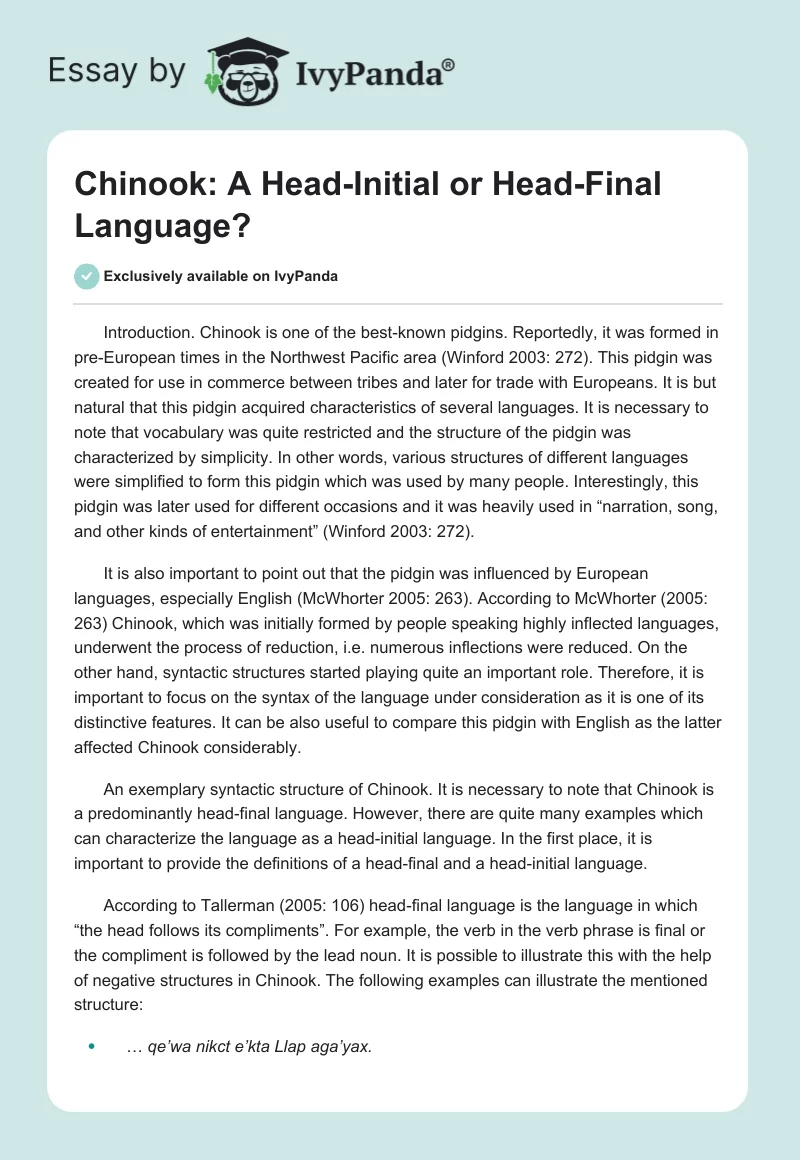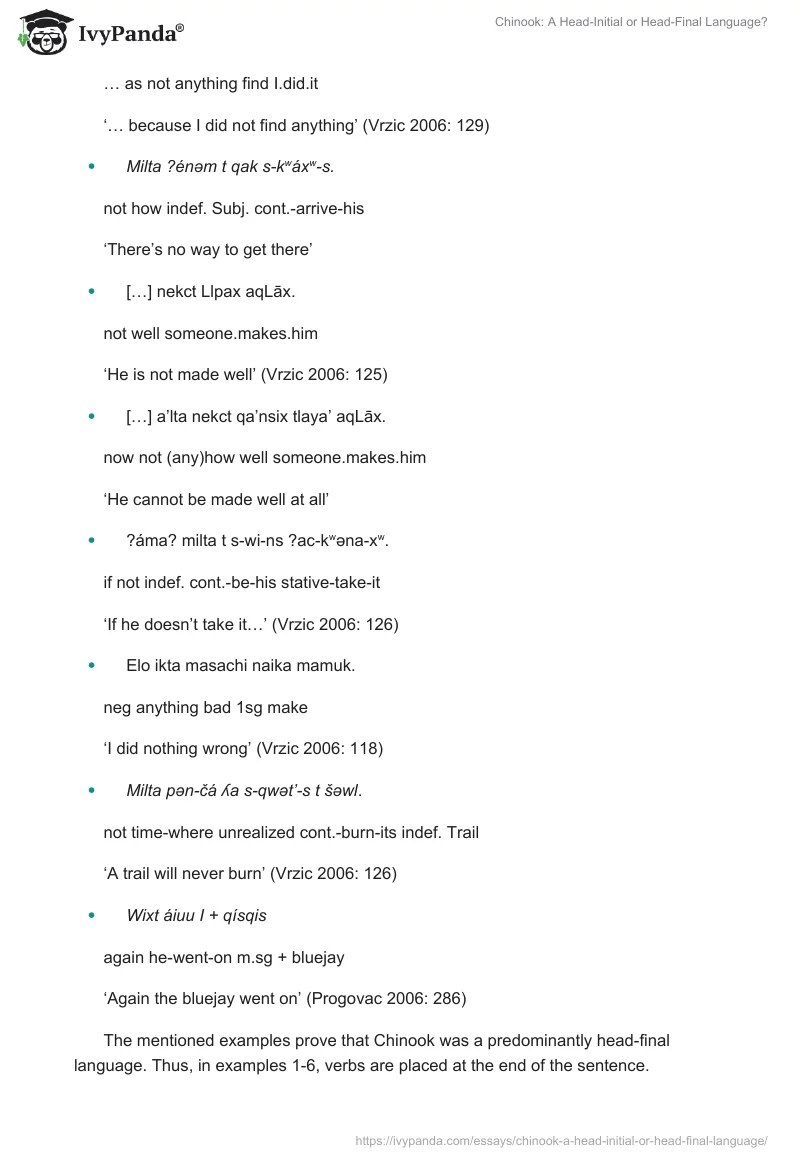Introduction. Chinook is one of the best-known pidgins. Reportedly, it was formed in pre-European times in the Northwest Pacific area (Winford 2003: 272). This pidgin was created for use in commerce between tribes and later for trade with Europeans. It is but natural that this pidgin acquired characteristics of several languages. It is necessary to note that vocabulary was quite restricted and the structure of the pidgin was characterized by simplicity. In other words, various structures of different languages were simplified to form this pidgin which was used by many people. Interestingly, this pidgin was later used for different occasions and it was heavily used in “narration, song, and other kinds of entertainment” (Winford 2003: 272).
It is also important to point out that the pidgin was influenced by European languages, especially English (McWhorter 2005: 263). According to McWhorter (2005: 263) Chinook, which was initially formed by people speaking highly inflected languages, underwent the process of reduction, i.e. numerous inflections were reduced. On the other hand, syntactic structures started playing quite an important role. Therefore, it is important to focus on the syntax of the language under consideration as it is one of its distinctive features. It can be also useful to compare this pidgin with English as the latter affected Chinook considerably.
An exemplary syntactic structure of Chinook. It is necessary to note that Chinook is a predominantly head-final language. However, there are quite many examples which can characterize the language as a head-initial language. In the first place, it is important to provide the definitions of a head-final and a head-initial language.
According to Tallerman (2005: 106) head-final language is the language in which “the head follows its compliments”. For example, the verb in the verb phrase is final or the compliment is followed by the lead noun. It is possible to illustrate this with the help of negative structures in Chinook. The following examples can illustrate the mentioned structure:
- … qe’wa nikct e’kta Llap aga’yax.
… as not anything find I.did.it
‘… because I did not find anything’ (Vrzic 2006: 129)
- Milta ?énəm t qak s-kwáxw-s.
not how indef. Subj. cont.-arrive-his
‘There’s no way to get there’
- […] nekct Llpax aqLāx.
not well someone.makes.him
‘He is not made well’ (Vrzic 2006: 125)
- […] a’lta nekct qa’nsix tlaya’ aqLāx.
now not (any)how well someone.makes.him
‘He cannot be made well at all’
- ?áma? milta t s-wi-ns ?ac-kwəna-xw.
if not indef. cont.-be-his stative-take-it
‘If he doesn’t take it…’ (Vrzic 2006: 126)
- Elo ikta masachi naika mamuk.
neg anything bad 1sg make
‘I did nothing wrong’ (Vrzic 2006: 118)
- Milta pən-čá ʎa s-qwət’-s t šəwl.
not time-where unrealized cont.-burn-its indef. Trail
‘A trail will never burn’ (Vrzic 2006: 126)
- Wixt áiuu I + qísqis
again he-went-on m.sg + bluejay
‘Again the bluejay went on’ (Progovac 2006: 286)
The mentioned examples prove that Chinook was a predominantly head-final language. Thus, in examples 1-6, verbs are placed at the end of the sentence. Therefore, these sentences are good illustrations of Tallerman’s definition of a head-final language as the verb is in the final position. Interestingly, in examples 7 and 8, the noun is in the final position. Basically, the conventional structure SVO, which is one of the major characteristics of English, is not used in Chinook. The structure VOS is used. This characteristic feature of Chinook will be considered a bit later.
At this point, it is necessary to provide a definition of a head-initial language as Chinook cannot be regarded as purely head-final language. According to Tallerman (2005: 106) a head-initial language is the language in which compliments follow the head word. Chinook also had examples of such structures which were quite widespread. Researchers provide other examples. For instance, Winford (2003: 282) provides the following example:
- wik alqi msayka atá nayka
neg fut 2 pl wait-for 1sg
“You won’t have to wait for me”
There are more examples of such structures:
- Ixt man yaka kuli kupa lamatáy
One man 3sg go to mountain
‘One man went to the mountain’ (Progovac 2006: 286)
- Wek kata nsaika mamuk ikta.
neg anyhow 1pl do anything
‘We couldn’t do anything’ (Vrzic 2006: 118)
It is obvious that these structures are common for head-initial languages like English. In these examples, the structures of phrases and entire sentences are similar to English.
Word order. The syntactic structure mentioned above is also manifested in the word order. It is possible to state that head-initial languages often have the following structure: SVO. Of course, it is necessary to note that this word order is typical for highly structured languages like English. However, as has been mentioned above Chinook acquired some traits of English and other European languages. Inflections started playing less important role in Chinook, whereas structure and word order became more important. Nonetheless, Chinook did not develop such strict structure as English. However, the influence of this language (and other Europen languages) is still significant as different word order structures appeared. Therefore, researchers point out that “all word order possibilities” can be found in Chinook (Steele 1978: 599).
- tgigE’nxautē ikanā’tē tEmēwāilEma
(V) (O) (S)
“they:watch:it soul ghosts”
‘The ghosts watch a soul.’ (Steele 1978: 599)
- aqui’nEmikc tkalā’mukc atqā’qcx ō’lExkul
(S) (V) (O)
“five:men they:hold:her in:their:mouths dried:salmon”
‘Five men hold dried salmon in their mouths.’
- ē’ō’k aLgē’lElōtx kLtōplEnā’n tē’lx Em
(O) (V)
“blanket he:gives:it:to:them”
‘He gives a blanket to those who named the people.’
Therefore, it is quite difficult to define Chinook as a purely head-initial or head-final language.
Contrasting the two languages. It can be interesting to contrast Chinook and English in terms of the syntactic structure under consideration. Tallerman (2005) claims that English is a head-initial language. Tallerman (2005: 106) provides the following examples: “likes chips”, “into the water”, “fond of chips”, “admiration for Kim”, etc. In fact, this assumption can be illustrated by the examples mentioned in this paper. Thus, in example (1), the phrase “…I did not find anything” is a good illustration (Vrzic 2006: 129). The verb is placed in the initial position, i.e. it is followed by its compliment ‘anything’. Basically, all the examples provided in the paper (from 1 to 14) can be used as illustrations of the specific structure of English. In each of these examples, head word is followed by its compliment(s). The verb is followed by the object, so the head word is placed in the initial position. When it comes to Chinook, it is impossible to answer the question whether it is a head-initial or head-final language. There are examples of both structures. However, it is necessary to add that there are more examples of the structure when the head word follows its compliment. Thus, whereas English is a purely head-initial language, Chinook is a predominantly head-final language.
This peculiarity of the language can be explained by the fact that Chinook is a pidgin which was formed on the basis of several languages. Therefore, American Indian languages which were characterized by inflections were combined with European languages (including English) which were characterized by quite different structures. Therefore, Chinook acquired new forms, but preserved certain traits of American Indian languages. One of the features acquired from European languages was the structure which was typical for these languages. Thus, Chinook had forms typical for head-final languages. This was manifested in phrases or in entire sentences. For instance, the structure typical for American Indian languages SOV was not the only possible word order in Chinook (Steele 1978: 588). The language adopted new forms typical for head-initial languages. This led to the development of such structures as the following word order structures: SOV, SVO, VOS and OV.
The development of Chinook structure is meaningful for researchers. Admittedly, peculiarities of Chinook can provide researchers with quite important data concerning the laws of the language development. Notably, pidgins are most exemplary languages as they are developed to serve to a particular purpose. Chinook was developed for commerce. The ‘simplest’ and the most common features of the languages were used. Basically, it is possible to state that universal traits of languages were used to form Chinook. The structure of the language is a mixture of these universal traits.
Therefore, it is possible to note that the structure of head-initial languages is one of these universal traits as Chinook acquired some forms typical for such languages. These typical structures affected the word order. Eventually, Chinook was characterized by a mixture of possible types of word order, whereas American Indian languages were characterized by SOV word order. Interestingly, inflections were proved to be less important as Chinook ‘preserved’ only few inflections (as compared to other American Indian languages). However, it is possible to point out that the structure of European languages was not adopted completely. Chinook preserved conventional forms of American Indian languages as well. It never became a purely head-initial language like English.
Conclusion. On balance, it is possible to state that Chinook is quite a specific pidgin which was developed for use in commerce, but was later found in different sociolinguistic instances (in songs, narratives). As any other pidgin, Chinook acquired traits of several languages, both American Indian and European languages. The structure of Chinook is one of the most significant traits of this language. Chinook can be referred to as a predominantly head-final language. In contrast to English, which is a purely head-initial language, in Chinook the head word follows its compliment(s) in the majority of cases. However, as Chinook was affected by European languages, it acquired some forms typical for head-initial languages. Importantly, this trait is manifested on the level of phrases and entire sentences. Thus, the word order which became more important was also altered in a way. Apart from SOV word order structure, other word order structures were found in Chinook. Finally, it is important to note that the structure of Chinook is very illustrative in terms of development of the language. It is possible to trace universal structures and language traits while considering such languages as Chinook.
References
McWhorter, John H. 2005. Defining Creole. New York: Oxford University Press.
Progovac, Ljiljana. 2006. The syntax of nonsententials: multidisciplinary perspectives. Philadelphia, PA: John Benjamins Publishing Company.
Steele, Susan. 1978. Word order variation: A typological study. In Joseph Greenberg (ed.), Syntax, 585-625. Stanford, CA: Stanford University Press.
Tallerman, Maggie. 2005. Understanding syntax (second edition). Oxford: University Press.
Vrzic, Zvjesdana. 2006. Syntactic properties of negation in Chinook Jargon, with a comparison to two source languages. In Ana Deumert and Stephanie Durrleman (eds.), Structure and variation in language contact, 111-135. Philadelphia, PA: John Benjamins Publishing Company.
Winford, Donald. 2003. An introduction to contact linguistics. Malden, MA: Wiley-Blackwell.


